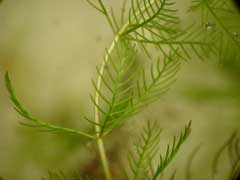 |
|
http://commons.wikimedia.org/wiki/File:Cleaned-Illustration_Myriophyllum_spicatum.jpg |
 |
| http://commons.wikimedia.org/wiki/User:Fabelfroh |
Translate this page:
Summary
Physical Characteristics
![]()
![]() Myriophyllum spicatum is a PERENNIAL.
Myriophyllum spicatum is a PERENNIAL.
See above for USDA hardiness. It is hardy to UK zone 6. It is in flower from June to July. The species is hermaphrodite (has both male and female organs) and is pollinated by Wind.
Suitable for: light (sandy) and medium (loamy) soils. Suitable pH: mildly acid, neutral and basic (mildly alkaline) soils and can grow in very alkaline soils.
It cannot grow in the shade. It can grow in water.
UK Hardiness Map
US Hardiness Map
Synonyms
Plant Habitats
Pond;
Edible Uses
Edible Parts: Root
Edible Uses:
Root - raw or cooked[257]. Sweet and crunchy, the roots were a much relished food for several native North American Indian tribes[257].
References More on Edible Uses
Medicinal Uses
Plants For A Future can not take any responsibility for any adverse effects from the use of plants. Always seek advice from a professional before using a plant medicinally.
Demulcent Febrifuge
The plant is demulcent and febrifuge[178].
References More on Medicinal Uses
The Bookshop: Edible Plant Books
Our Latest books on Perennial Plants For Food Forests and Permaculture Gardens in paperback or digital formats.

Edible Tropical Plants
Food Forest Plants for Hotter Conditions: 250+ Plants For Tropical Food Forests & Permaculture Gardens.
More

Edible Temperate Plants
Plants for Your Food Forest: 500 Plants for Temperate Food Forests & Permaculture Gardens.
More

More Books
PFAF have eight books available in paperback and digital formats. Browse the shop for more information.
Shop Now
Other Uses
References More on Other Uses
Cultivation details
Requires a sandy medium, rich in decaying organic matter, in full sun[200]. Plants overwinter as resting buds at the bottom of the pond[1]. Another report says that the plants do not form winter buds, but persist at the bottom of the pond[56]. This species is considered to have the potential to be invasive when introduced into some areas such as Texas[274]. A good water oxygenator[200].
References Carbon Farming Information and Carbon Sequestration Information
Temperature Converter
Type a value in the Celsius field to convert the value to Fahrenheit:
Fahrenheit:
The PFAF Bookshop
Plants For A Future have a number of books available in paperback and digital form. Book titles include Edible Plants, Edible Perennials, Edible Trees,Edible Shrubs, Woodland Gardening, and Temperate Food Forest Plants. Our new book is Food Forest Plants For Hotter Conditions (Tropical and Sub-Tropical).
Shop Now
Plant Propagation
Seed - we have no information for this species but the seed is quite probably of limited germination, especially if it becomes dry, and so is best sown as soon as it is ripe in a cold frame if this is possible. Otherwise store the seed in a cool place in a jar of water and sow in the spring. Keep the pots in trays of water. When they are large enough to handle, prick the seedlings out into individual pots and plant them out in the spring. Cuttings can be inserted directly into the soil of the pond at any time in the growing season[56]. Division.
Other Names
If available other names are mentioned here
Native Range
TEMPERATE ASIA: Afghanistan, Egypt (Sinai), Iran (west), Israel, Jordan, Lebanon, Syria, Turkey, Russian Federation-Ciscaucasia (Ciscaucasia), Russian Federation-Eastern Siberia (Eastern Siberia), Russian Federation (Altay), Kazakhstan, Kyrgyzstan, Tajikistan, Turkmenistan, Uzbekistan, Mongolia, Russian Federation (Kurile Islands, Primorye, Kamcatskij kraj, Sakhalin), China, Japan (Hokkaidô, Honshu, Kyushu, Shikoku) TROPICAL ASIA: India (north), Nepal, Pakistan EUROPE: Denmark, Finland, United Kingdom, Ireland, Iceland, Norway, Sweden, Austria, Belgium, Switzerland, Czech Republic, Germany, Hungary, Netherlands, Poland, Slovakia, Russian Federation (European part), Belarus, Moldova, Ukraine (incl. Krym), Albania, Bulgaria, Greece (incl. Crete), Croatia, Italy (incl. Sardinia, Sicily), Romania, Slovenia, Spain (incl. Baleares), France (incl. Corsica), Portugal AFRICA: Algeria, Egypt, Morocco, Tunisia
Weed Potential
Right plant wrong place. We are currently updating this section.
Please note that a plant may be invasive in one area but may not in your area so it’s worth checking.
Conservation Status
IUCN Red List of Threatened Plants Status :

Growth: S = slow M = medium F = fast. Soil: L = light (sandy) M = medium H = heavy (clay). pH: A = acid N = neutral B = basic (alkaline). Shade: F = full shade S = semi-shade N = no shade. Moisture: D = dry M = Moist We = wet Wa = water.
Expert comment
Author
L.
Botanical References
17200
Links / References
For a list of references used on this page please go here
Readers comment